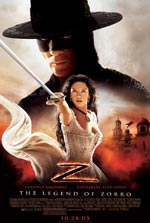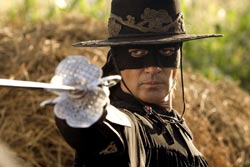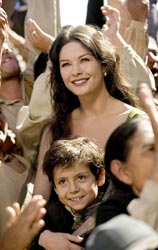
The Legend Of Zorro

 – for sequences of violence/peril and action, language and a couple of suggestive moments.
– for sequences of violence/peril and action, language and a couple of suggestive moments.
Director: Martin Campbell
Starring: Antonio Banderas, Catherine Zeta-Jones
Running Time: 2 hours, 6 minutes
Theatrical Release Date: October 28, 2005
Official Site

Plot Summary
The year is 1850 and our swashbuckling crusader is challenged by the most dangerous mission of his life. After fighting to help California become the 31st state of the Union, Zorro (Banderas) must live up to the promise he made his wife Elena (Zeta-Jones) – to give up his secret identity and live a normal life as Alejandro de la Vega. When he hesitates, it threatens to tear them apart. Now, the same forces that conspired to keep California from becoming part of the United States are plotting to unleash a threat that has been 500 years in the making, a threat that could change the course of history forever. And only Zorro can stop it. (from Sonypictures.com)
Film Review
In 1998, legendary swashbuckling hero Zorro returned to the big screen in The Mask Of Zorro. The film was well-casted, putting Antonio Banderas in the black mask and cape and delivering the stunning Catherine Zeta-Jones a breakout role. The PG-13 film was a near-instant classic, but suffered from some truly unnecessarily violent and gross content that hindered the film from being a staple family film. 2005’s The Legend Of Zorro is the belated sequel that tones down the franchise for the family, albeit still remaining quite violent at times.
I have to admit that although it seems to have taken forever to finally give the film a sequel, it was great to see Banderas and Zeta-Jones in their roles together again. Legend, having been toned down for family, is strung together by more adult themes, building much of the story around the marital tension between Alejandro and Elena. Set ten years after the 1998 story, the couple are raising their sun Joaquin, who knows nothing of his father’s heroics, and barely knows him because of his secrets. Elena has grown tired of Alejandro’s role as Zorro and longs for him to settle down as the three of them. The story weaves this element into the main plot quite well, offering a few interesting twists and turns along the way.
I was pleasantly surprised how good newcomer Adrian Alonso was as their son Joaquin. I have to admit I was quite terrified how the two of them having a son would affect the film (let’s not forget how silly and poorly executed the main characters in The Mummy Returns having a son ended up being). Thankfully, I found the child to be a terrific little actor who was able to be mischievous yet charming and believably emotional when needed. It was excellent to see Banderas don the mask once again, and for Zeta-Jones to return to her firecracker of a role. Unfortunately, Zorro does take a back seat to Joaquin and even the drama between Armand and Elena for good portions of the film. But some of Legend‘s best moments is when Alejandro and Elena are interacting or the three are together.

The action was mixed. Some stunts were spectacular while a lot of the special effects were second-rate at best (the fire effects were especially cheesy). It seemed kind of strange to watch Zorro fight and never stab anyone with his sword, but there was plenty of gunfire and physical fighting in the film. But the violence surprised me at times. It’s especially stuff like a scene where a man’s head is blown up by explosives off-screen that I was surprised to find in a PG film. There’s also another brief intense sequence where Elena finds a couple discolored dead men who had been murdered stashed in a closet. Another scene involves a shoot-out at a ranch that leaves a character dead with his wife weeping hysterically over him. It just seemed that some moments seemed rather heavy for a targeted younger audience.
The Legend Of Zorro possesses a sort of strange spirituality to it. McGivens, the chief villain in the film, spouts scripture and commits evil and violent crimes in the name of the Lord. However, the film balances this out with the
presence of Friar Felipe who is more true to his faith, and Alejandro’s leanings to seeking God’s direction for his role as Zorro. I was a little concerned with the portrayal of McGivens as being so evil while claiming to be a doer of God’s work, but I was glad to see the good guys given a healthy belief and devotion in the Father to contrast it. McGivens made for a great villain, but his portrayal was still borderline to a degree.
All in all, I ended up really enjoying The Legend Of Zorro. It may not be as strongly written and played-out as its predecessor The Mask Of Zorro, but it’s a more than worthy sequel, and one of the better follow-ups for a series
in recent memory (not like the travesty Men In Black II or the silly and problematic Shanghai Knights, for example). Most fans of the 1998 film should enjoy this installment, while those looking for an exciting family outing will definitely find one in The Legend Of Zorro, but will want to proceed with caution nonetheless.
– John DiBiase, (reviewed: 11/2/05)
Parental Guide: Content Summary
![]() Sex/Nudity: Alejandro and Elena kiss very passionately a few times during the film; Elena wears dresses common to the era the film takes place in that reveal varying amounts of cleavage; We see Alejandro in a tub with his fellow Dons playing cards. He gets out and we see him drying off with a towel (we don’t see any nudity); Alejandro is wakened by a maid and he gets out of bed only to discover that he is naked (we don’t see anything); Elena and Alejandro slice their initials “E Z” into a man’s underwear and we see the bare skin through the cuts in his clothing
Sex/Nudity: Alejandro and Elena kiss very passionately a few times during the film; Elena wears dresses common to the era the film takes place in that reveal varying amounts of cleavage; We see Alejandro in a tub with his fellow Dons playing cards. He gets out and we see him drying off with a towel (we don’t see any nudity); Alejandro is wakened by a maid and he gets out of bed only to discover that he is naked (we don’t see anything); Elena and Alejandro slice their initials “E Z” into a man’s underwear and we see the bare skin through the cuts in his clothing
![]() Vulgarity/Language: 1 incomplete “a” word, 1 “h*ll,” 1 “S.O.B.” (in subtitles), 3 “G-d”
Vulgarity/Language: 1 incomplete “a” word, 1 “h*ll,” 1 “S.O.B.” (in subtitles), 3 “G-d”
![]() Alcohol/Drugs: We see Felipe and Alejandro drinking wine at a party; Alejandro drinks a lot of wine very fast and gets completely drunk. We then see him drinking more from a bottle later on and his horse drinking from the bottle too; Elena orders a double tequila; some other characters casually have wine or other kinds of alcohol during the film
Alcohol/Drugs: We see Felipe and Alejandro drinking wine at a party; Alejandro drinks a lot of wine very fast and gets completely drunk. We then see him drinking more from a bottle later on and his horse drinking from the bottle too; Elena orders a double tequila; some other characters casually have wine or other kinds of alcohol during the film
![]() Blood/Gore: McGivens has a cross-shaped scar on his cheek; Zorro hits McGivens in the jaw and we briefly see him spitting out his teeth with a little bit of blood; McGivens falls into a patch of cacti and emerges with needles sticking out of his face (with just a little blood around his mouth); We see McGivens holding a set of wooden teeth, sharpening them with a knife before putting them in his mouth; A character is shot off-screen and we see them walk out of a building and collapse to the floor. We then see a little bit of blood on their shirt in the back where they had been shot; We see a tiny bit of blood on a ripped portion of Joaquin’s sleeve, presumably from an unseen wound; We see two dead bodies that are discolored from being dead for a little while, but aren’t especially bloody or gory
Blood/Gore: McGivens has a cross-shaped scar on his cheek; Zorro hits McGivens in the jaw and we briefly see him spitting out his teeth with a little bit of blood; McGivens falls into a patch of cacti and emerges with needles sticking out of his face (with just a little blood around his mouth); We see McGivens holding a set of wooden teeth, sharpening them with a knife before putting them in his mouth; A character is shot off-screen and we see them walk out of a building and collapse to the floor. We then see a little bit of blood on their shirt in the back where they had been shot; We see a tiny bit of blood on a ripped portion of Joaquin’s sleeve, presumably from an unseen wound; We see two dead bodies that are discolored from being dead for a little while, but aren’t especially bloody or gory
![]() Violence: The film is very violent for a PG-rated film: We see many characters punched, kicked and slashed-at by swords; A vial of nitroglycerin is thrown at a character and explodes, killing them (we don’t see the aftermath); two men are murdered off-screen and we later see their non-gory corpses; a man is shot, apparently dead, but we find later on that they’ve survived; a drop of nitroglycerin drips onto a character’s head and explodes, killing them (not shown); a character puts a wine bottle filled with nitroglycerin into the back of someone’s pants and throws them from a moving train. The person lands in a crowd of people (villains, of course), and
Violence: The film is very violent for a PG-rated film: We see many characters punched, kicked and slashed-at by swords; A vial of nitroglycerin is thrown at a character and explodes, killing them (we don’t see the aftermath); two men are murdered off-screen and we later see their non-gory corpses; a man is shot, apparently dead, but we find later on that they’ve survived; a drop of nitroglycerin drips onto a character’s head and explodes, killing them (not shown); a character puts a wine bottle filled with nitroglycerin into the back of someone’s pants and throws them from a moving train. The person lands in a crowd of people (villains, of course), and
explodes, killing everyone; A train crashes and explodes, killing a villain. Other related violence occurs during the film…
